In this issue
Ecogardening & wildlife
Biochar – what difference does it make?
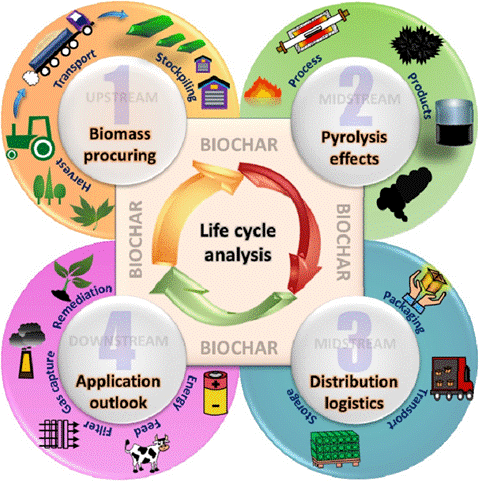
-Rafaele Joudry
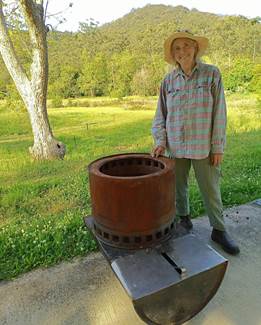
I tried putting Biochar on my garden once. I spent a day reading up on the internet, got excited and started fiddling around, going to the shops, collecting tins of various sizes. By afternoon, I made my own mini biochar burner and burnt some twigs. I didn’t know what I was doing, and probably produced a low value type of wood charcoal which would not change the world.
Then I met Stephen Joseph—world renowned Biochar researcher, educator and expert, who happens to live in our neighbourhood. I noticed that he had exceptionally healthy vegetables growing, even in a shady area under gum trees. I mentioned that my efforts with biochar made no noticeable difference, to which he replied, “Well, you didn’t infuse it with organic nutrients did you?”
I realised there is more to biochar than meets the beginner’s eye – and began the conversation about having Stephen come and offer an interactive, hands-on workshop at Narara Ecovillage.
What is Biochar?
Sources: What is Biochar?, Ancient Amazonians created mysterious ‘dark earth’ on purpose, Terra Preta, the Black Earth upon which Civilisations were Built; Biochar could help mitigate climate change and be useful on pastoral properties, research suggests
Biochar is a charcoal-like substance made by burning organic material (biomass), such as from agricultural and forestry waste, in a controlled process called pyrolysis.
In the pyrolysis process, organic materials are burned in a container with very little oxygen. This produces biochar, a stable form of carbon that cannot easily escape into the atmosphere.
In addition, the energy or heat created during pyrolysis can be captured and used as a form of clean energy, depending on the feedstock used.
In our current climate-conscious world, where communities and companies are searching for ways to mitigate carbon release, biochar has significant potential.
Biochar has a long and fascinating history, going back to ancient times. Civilizations from China to Japan to ancient Peru and aboriginal Australia, made and used biochar. In the Amazon, biochar was used to create deep, rich black, fertile soils known as Terra Preta, which astonished early European explorers.
Terra preta is less vulnerable to nutrient depletion by rain or flooding, as the porous biochar structure enables it to collect and store a high concentration of essential microorganisms, while simultaneously resisting any leeching. One other astonishing quality is its self-sustaining ability to mineralise, so plants can grow deeper into the soil. The regenerative properties are still puzzling to soil experts, with the cause lying somewhere in the unique microbial content, containing thousands upon thousands of bacterial species and fungi. Studies show that biochar, if used correctly, can help build organic carbon in soil by up to 20 per cent and can reduce nitrous oxide emissions from soil by 12 to 50 per cent.
Biochar expert Professor Stephen Joseph will present a workshop at Narara Ecovillage on Dec 1st 2024. More details here: Making biochar for home use and community application | Narara Ecovillage
Winning the War on Weeds

Cardboard as weed suppressant vs the hard work of hand pulling a weed.
-Gillian Welstead
“One of the most important Permaculture principles is that weeds are good”
Looking for alternatives to time-consuming, inefficient and endless hand weeding? Permaculture designer and community garden organiser Gillian shows how cardboard, wood chips, a dutch hoe & planting can beat the weeds.
One of the most important Permaculture principles is that weeds are good. They do good by populating the soil and holding it together, maintaining moisture, sequestering carbon, nitrogen and other nutrients, and providing the heat and moisture for your compost.
A definition of a weed is any plant that is growing where you don’t want it. Most of the weeds which are out of control in our urban environment are introduced, and compete with native species. However, they do contribute to the ecosystem by providing alternative food for birds, nectar for insects & habitat for frogs not to mention retaining millions of bio-organisms that keep our soil fertile.
However, sometimes the weeds have just got to go.
Hand weeding
As a general rule, there is no point in pulling out weeds unless you put something in their place. Pulling up weeds leaves a growing space in the soil for the next batch of weeds, which might be much worse. This method also allows the sun to degrade the bare soil and reduce the amount of water that can be retained, causing runoff and erosion. In addition, when you throw weeds away, they are usually carrying valuable soil round their roots, plus critters that live in the soil. (But as with all things in nature there are exceptions, such as those that have set seed and are ready to spread far and wide (e.g. Fleabane), and noxious notifiable weeds (e.g. Fireweed)- pull them out,and/or cut the seed heads into bags and put them in the council green bin, or hot compost them yourself if you can.)
Alternative strategies to hand weeding
- Mow or whipper snip large areas, but not too short. Rake up grass clipping and hot compost.
- Dump a pile of wood chips on individual weeds until you can replace the weed with something delicious or beautiful. Bulk wood chips are often available from local arborists or councils. Please avoid buying wood chips in plastic bags!
- Mulch larger gardens and paths with wood chips. You can also use fallen leaves, grass clippings (sparingly as they can heat up, thereby damaging the soil) or stones, (dew condenses on them and waters the soil). Remember that wood chips distributed too thinly, less than 5 cm deep, can encourage weed growth. More than 10 will kill and subdue weeds, except for occasional incursions from those that grow horizontally like couch grass. The big bonus is the little white curl grubs, which are the larvae of Christmas Beetles, will transform wood chips to compost. You may have to replace your wood chips every two years. Avoid digging wood chips in until they have rotted.
- Avoid weed mat as it can help degrade the soil, prevent the movement of beneficial insects between layers, reduce biodiversity and is predicted to become a major environmental hazard. Use cardboard and layers of newspaper instead which break down into healthy living soil. Remember to remove any plastic tape first! (See our photos)
- Hoe just below the root node where the foliage starts. The top will dry out in the sun- making mulch- while the roots decompose- composting the soil. The ancient sharp Dutch Hoe is a brilliant tool for weeding large areas, between vegetables, and under shrubs. It uses large muscle groups, instead of stressing hands and wrists. Using a Dutch Hoe takes practice to master the technique but is more efficient than hand weeding (see Gardening Australia video below).
- Plant, plant, plant. Have every arable surface planted with Australian natives and your favourites to bring the tiny birds back to our neighbourhoods, shade out weeds and make hand weeding unnecessary. There are also many drought hardy ground covers that leave little room for Weeds.
For further info: Weeds 101 (abc.net.au); Weeds Australia: https://weeds.org.au/
And this helpful very short Gardening Australia video explaining 3 different hoes: the stirrup hoe, dutch hoe and chipping hoe.

Get Ready for Australia’s Biggest Frog Count!
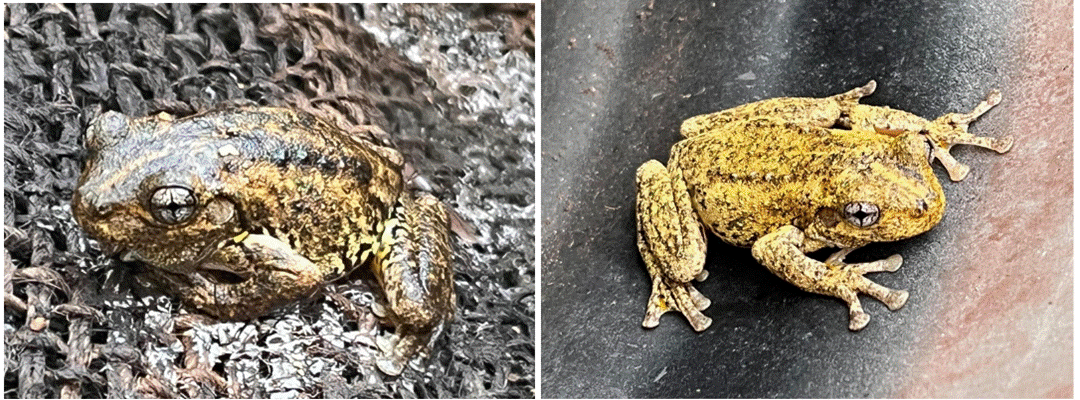
-Lorraine Hawdon
FrogID Week is an annual celebration that deepens our national understanding of frogs. Join in from November 8-17 for the seventh annual FrogID Week, where we will record frog calls and further enrich The Australian Museum’s extensive dataset on frog biodiversity.
Every call counts during FrogID Week – even if you hear the same frog in the same pond, stream or dam each day or night, your contributions will help in understanding changes in frog populations, their breeding habitats and trends over time.
Download the free FrogID app and get ready to record frog calls during Frog ID Week, 8-17th November.
More information and app download here: https://www.frogid.net.au/frog-id-week
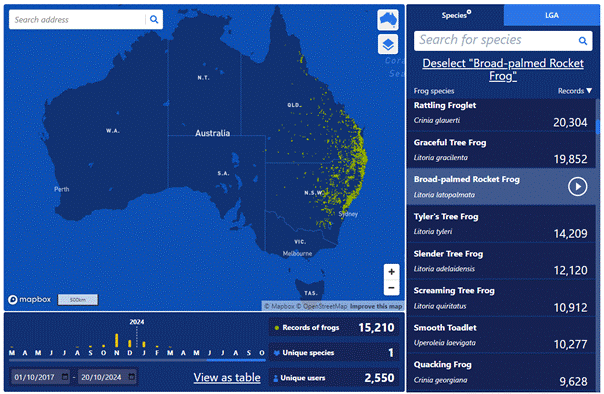
Testimonial from Lincoln – a dedicated FrogID user living at Narara Ecovillage
A few years ago, a friend introduced me to the FrogID app. As a keen iNaturalist user and mushroom hunter I latched onto it. Since then, I’ve gradually gotten to know the frog calls and, with an eye roll from the kids, even ventured out looking for frogs on a recent holiday.
So far this frog season I’ve contributed about 20 recordings, mostly right outside my house at the Ecovillage. Maybe because I’m more attuned to them, but there certainly feels to be more both in numbers but also species.
Those calling at the moment include:
- Adelotus brevis – Tusked Frog
- Crinia signifera- Common Eastern Froglet
- Litoria peronii – Peron’s Tree Frog (pictured above)
- Litoria fallax – Eastern Dwarf Tree Frog
- Litoria tyleri – Tyler’s Tree Frog
- Limnodynastes peronii – Striped Marsh Frog
- Uperoleia fusca – Dusky Toadlet
- Litoria Verreauxii – Whistling Tree Frog
Weed of the Month: Mickey Mouse plant (Ochna serrulata)

-Donna Carey
Ochna is a very common weed that is flowering now in bushland and gardens, so it’s a great time to identify and remove it.
What is it?
Ochna serrulata is a shrub that is native to southern Africa. It is not a weed of national significance but nevertheless, it is invasive and a significant environmental problem.
Widely planted in Australian gardens for its strikingly attractive flowers, this weed is often seen growing in bushland from dumped rubbish and bird-dispersed seed. It invades bare areas of disturbed riparian habitat.
What does Ochna look like?
Ochna is a member of the Ochnaceaefamily. It grows as an erect woody shrub up to about 2.5 m high. Leaves are oblong to elliptical, up to 5 cm long, narrow and shiny with serrated margins. New growth usually has a bronze tinge. Flowers are bright yellow with five petals. These petals fall off, leaving five sepals which turn scarlet red when the fruits appear. Fruits are round and initially green, turning glossy black in summer on ripening.
The root is an angled tap root that is easily broken when hand pulled, hence the plant easily reshoots.
Why is Ochna a problem?
Ochna is easily dispersed to new areas when birds eat the fruits and spread the seeds.
What do I do when I find Ochna?
For young seedlings, hand pulling is generally the most successful method of control. Take care not to break the tap root. Larger individuals may need to be grubbed out with a mattock. Here at Narara we use a wonderfully effective hand tool called a “Tree Popper” as it is the best tool for removing small and medium sized plants.

References
- Weeds Australia: https://weeds.org.au/profiles/ochna-mickey-mouse/
- Qld Dept Agriculture and Fisheries: Ochna or Mickey Mouse plant
Terrestrial Orchid Time

-Olga and Guy
With our subtropical climate (becoming warmer and wetter), Narara Ecovillage is blessed with life, flowers and orchids all year round. The flowers are most diverse in spring and include native orchids in two areas within the cleared land. Watch out for these beauties: Blunt Greenhoods, Sun Orchids and Onion Orchids that may be flowering now in your local area!
Sun Orchids (Thelymitra species) get their name for the habit of opening only on warm days in full sunshine. Their delicate petals add a stunning contrast to the surrounding greenery. The slender sun orchid (T. pauciflora), pictured, is particularly special, as it often stays closed, waiting for just the right conditions. Curiously, this particular species of sun orchids can self-pollinate, making it a master of adaptation in various environments! Sun Orchids
Onion Orchids (Microtis species) are less showy but they’re fascinating in their own quiet way. Identifying orchids can be a challenge, with many species looking very similar unless using a hand-lens and a good reference book. We think that these are Common Onion Orchids and Slender Sun Orchids but hopefully one of the kind experts on the iNaturalist app will help to identify our photos! These orchids need relatively open grassland to flower and we aim to cut these areas after they have set seed in mid-summer. Named for their underground tubers that smell faintly like onions, these small flowers are loved by tiny pollinators, like wasps and some wingless ants, which like the sweet nectar at the base of the flower. Onion Orchids
Greenhood Orchids Close to our entrance is an area of mown grass that supports three species of greenhood orchid. Over 300 Blunt Greenhood (Pterostylis curta) flowers were counted this year with smaller numbers of Nodding Greenhoods (Pterostylis nutans). Last year there were also some Maroonhoods (Pterostylis pedundulata) which we hope will return next year. Greenhood orchids

Ecoliving
Banksia Sustainability Awards finalist: how we got there
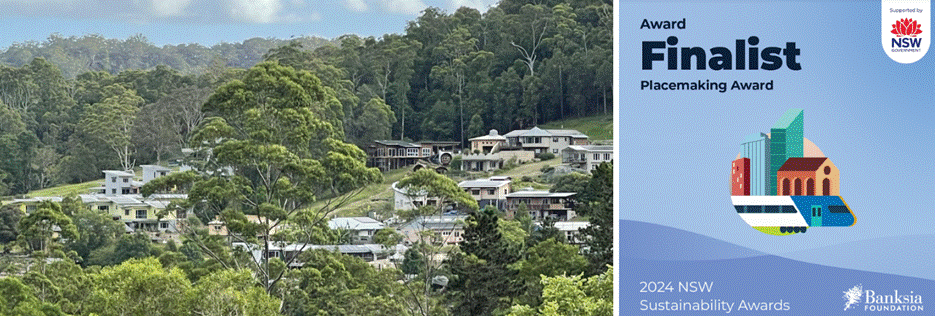
-Tanya Mottl & Dave Burrows
A sustainability event at the village. Award winners will be announced on 15 November 2024
Narara Ecovillage has been named as a Finalist in the 2024 Banksia Sustainability Awards in the category of Place Making.
This award “celebrates infrastructure and built environment projects that prioritise sustainability through innovative design and practices. These initiatives demonstrate resource conservation, energy efficiency, circularity, renewable energy adoption, and biodiversity preservation, while emphasising social sustainability, inclusivity, mobility, well-being, and community engagement.”
A summary of Narara Ecovillage’s submission is below.
The winners of the 2024 Banksia Sustainability Awards will be announced on 15 November 2024.

Introduction
Narara Ecovillage (NEV), 86km north of Sydney, is a resilient and inclusive sustainable intergenerational community that demonstrates ways to thrive within the earth’s ecological capacity.
Objectives and Challenges
The project started with a group of people in Sydney wanting to live more sustainably in a community, rather than in traditional housing and in nuclear families. The Narara Ecovillage Co-operative (NEV) purchased the site from the State Government in 2013. Finding the site, raising the funds needed for purchase and negotiating with both the NSW Government and (then) Gosford City Council were all challenges that needed to be met.
Strategies and Actions
Prior to new houses being built, volunteers established systems to encourage a strong sense of community belonging through encouraging neighbourly interaction while respecting people’s privacy. NEV has adopted a form of governance called Sociocracy, which allows all voices to be heard, and makes for better decisions with greater buy-in from those affected by the decisions.
Houses minimise environmental impact through careful orientation, use of thermal mass, planting for privacy and temperature control, insulation, low water use, energy efficiency and environmentally friendly materials. Solar panels and a community battery provide almost all the village’s power needs. Green transport policies and waste minimisation are priorities. Food provided through the Coffee Cart and at Ecovillage meals is sourced on the Ecovillage land and from sustainable local suppliers, and a circular economy is in place. Bush regeneration is carried out on a large scale.
Impact and Results
The Narara Ecovillage Strategic Plan was developed in April 2022 and guides activities for the period from 2022-2030. The Strategic Objectives aim to increase biodiversity on NEV land; to produce 15,000kg of food annually; to improve Ecovillage members’ ratings for trust, collaboration, commitment and satisfaction; to achieve a reduction in net annual operational carbon emissions for NEV households; to provide worldwide outreach for its work; and to derive 30% of its annual operating costs from regenerative businesses by 2030.
Results to date show that bird and frog species are increasing; almost 2000kg of food is grown annually on NEV lands or by partners; community cohesion is promoted through conflict resolution and community activities; at least 397,000 people have been reached through media stories about the Ecovillage; and regenerative businesses are starting to contribute to operating costs.
Innovation and Uniqueness
Narara Ecovillage was conceived of from the beginning as a multi-generational community in which everyone from babies to the elderly can co-exist in safety and be supported to participate in both educational and enjoyable activities. One of the most common responses heard on Open Day is from visitors from Asia or Africa who say: “At last! I have never before seen in Australia a village like my home.”
Conclusion
Narara Ecovillage is only at the beginning of what is planned as a decades-long process. It provides a demonstration of an alternative to living in isolation and in sprawling houses on massive blocks. It is the way of the future for living sustainably in community.
Village smart grid showcased

-Tanya Mottl
Narara Ecovillage was recently featured in an investors group campaign aimed at promoting ways Australians can save money while investing in renewable energy.
The campaign, “Climate Action Pays Off’ is run by the Investor Group on Climate Change, an international network of investors focussed on understanding and responding to climate change.
The “Climate Action Pays Off’ campaign shows ordinary Australians transitioning to renewable energy, with Narara Ecovillage showcased for its smart grid.
- Find the full article here
Less is More meets Deep Ecology
“Hickel starts from the economics and ends up in the same place as Seed, arguing for the same shifts in both consciousness and practice.”
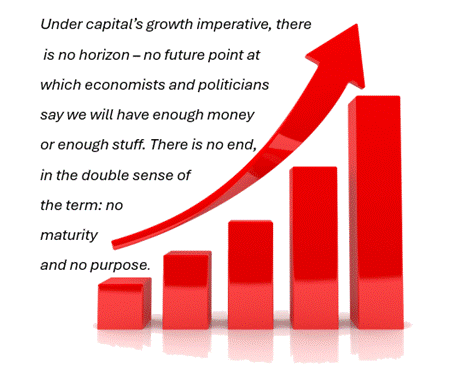
-Dave Burrows
Just finished the most impressive and most important book I’ve read in decades.
Less is More: How Degrowth Will Save the World by Jason Hickel is remarkable on several fronts but principally because it takes a whole raft of ideas in which I have long believed for social justice reasons – the need for a different system than current corporate capitalism, reduction of inequity and so on – and shows how these are utterly essential for preventing the death of the planet.
‘ A manifesto for a new politics and a new way of living in abundance with our planet ‘
I had encountered the exponential graphs of energy use before, but the biomass graphs and the relationship of these insane growth patterns to the core imperatives of capitalism I had never before seen so clearly expressed.
More importantly, Hickel places great emphasis on the need for a change in mindset, specifically in the way that humans view non-human beings and the very features of the earth itself.
I’m currently writing a biography of the rainforest activist, John Seed, who started from a position of seeing all creatures and features of the Earth as equally important, and who famously argues against the separation of humans from the non-human world. From there, he moved on to writing about the Religion of Economics – that can see the whole natural world as simply resources for humans to exploit.
Hickel starts from the economics and ends up in the same place as Seed, arguing for the same shifts in both consciousness and practice.
Our Narara Ecovillage, encompassing both John Seed’s Deep Ecology experience weekends and many of the degrowth practices Hickel describes, can be a crucible for trialling these new ways of looking beyond our current madness.
Empowering and hopeful despite the descriptions of where our current trajectory is leading us, this is a manifesto for a new politics and a new way of living in abundance with our planet.
More than 5 stars. (And thanks to another Villager, the ornithologist Guy Dutson, who recommended this book to me.)

Events
Mon Oct 21 & again Tue Oct 22: Ancient Futures & The Religion of Economics

Helena Norberg-Hodge argues how shifting economic policies from global to local will lead towards a more interconnected world, the foundation of human and ecological wellbeing.
John Seed tells the story of economics, a religion disguised as secular thought, and introduces The Work That Reconnects
- Sydney Event: Mon Oct 21, 5.30-8pm, Marrickville Golf Club Click for more info and registration for tonight’s Sydney event here
Central Coast event:
- When: Tue 22 Oct: ANCIENT FUTURES and THE RELIGION OF ECONOMICS
- Where: Narara Ecovillage Hall, 33 Gugandi Rd 2250
- Cost: By donation. A benefit for the Los Cedros Biological Reserve and for Local Futures
- More info & Registration (Central Coast): https://events.humanitix.com/helena-norberg-hodge-and-john-seed
Thur Oct 24: Community Energy – what is happening?

We hear much talk about Community Energy and how critical it will be in the energy transformation, but what is really happening in this space?
Renew Sydney Central Branch is hosting a panel of experts who will discuss what’s happening in the Sydney area and how people can get involved.
Speakers include: James Balzer from the NSW Dept Energy Climate Change & Sustainability, & Heidi Lee Douglas, CEO of Solar Citizens.
- When: Thursday 24th October, 6:00 – 7:30 PM. Doors open at 5:45 pm, webinar goes live at 6:30 pm
- Where: Inner West Sustainability Hub, 7 Prospect Rd Summer Hill
- Cost: Free
- More info & Registration: Attend in person or online.To register and for more info, go to This Link
Sat Oct 26: Narara Ecovillage Open Day

The Open Day (talk and tour) shows what Narara Ecovillage is all about, and demonstrates how we are activating a resilient community with ecological, social and economic potential by:
- shared food growing, natural retreats and Permaculture spaces
- shared community and workplaces
- examples of highly efficient low-carbon homes now and in the next stage
All are welcome.
- When: Sat Oct 26, 10.30am – 1.30pm
- Where: Narara Ecovillage Hall, 33 Gugandi Road 2250
- Cost: $15 includes talk & walking tour around village, kids & NELN members free!
- More Details and Registration
If this is your first visit to Narara Ecovillage, you may find this interesting: the Open Day Preview introduces the ecovillage and its unfolding story.
Mon Nov 4: Three Keys to Building Resilient Climate Communities: Free online event

Join Narara Eco Living Network member Tanya Mottl for an immersive online session focused on exploring local solutions amidst global challenges based on participation in the global Resilience 2.5 project. Learn why the Sustainable Development Goals matter to help transform paralysis into actionable change.
- When: Mon 4th November 12.30 – 1.30pm
- Where: Online
- Cost: Free
- Registration: https://bit.ly/4dMzqDu
Fri Nov 15 – Sun 17: Deep Ecology with John Seed, Tema Milstein and Jane Lynch

A waitlist is open for this event
- Registration: https://events.humanitix.com/deep-ecology-with-john-seed-tema-milstein-and-jane-lynch-narara-ecovillage-november-2024/tickets
- If you’d like to know more about these workshops, please see some reflections from recent workshop participants here.
Fri Nov 15- Sun 17: Power of Nature: Weekend EcoPsychology Retreat

Join the Friends of Foresthaven to explore the Power of Nature to inspire, heal, motivate and guide us in these uncertain times of great potential. Food provided
- When: Nov 15-17
- Where: Jagera EcoCommunity & Foresthaven, Maclean NSW, Camping
- Cost: $400 and $1200. Choose what you can afford, or contact us to arrange a payment plan, or apply for a scholarship.
- More info & registration: https://events.humanitix.com/power-of-nature-weekend-ecopsychology-immersion-24-yaegl-country-northern-nsw
Fri Nov 22- Sun 24: Rising Tide Kayak People’s Blockade & Festival

Join thousands stopping coal exports from the world’s largest coal port for 50 hours, including 2 full nights!
Workshops, speeches, kids activities,live music & floating dance parties – climate action has never been such fun!
- When: Friday 22- Sunday 22 November
- Where: Nobby’s Beach, Newcastle
- More details: https://www.risingtide.org.au/
Check out the First Wave Film on YouTube: https://youtu.be/3jZ4S4DlRbg. See 3000 people-power participants in last year’s blockade.
Sun Dec 1: Making biochar for home use and community application

A one-day intensive practical workshop presented by Stephen Joseph
Learn how to make your own biochar, and discover how and why this substance can transform your garden and solve planetary problems.
Presenter Stephen Joseph has received an AM for his work in renewable energy and biochar, and is now a visiting professor at University of NSW.
- When: Sunday December 1st, 8.30am-5pm
- Where: Narara Ecovillage Hall, 33 Gugandi Road 2250
- Cost: $199-120
- Click for more info and Registration here
Notices
New accommodation option at Narara Ecovillage

Narara Ecovillage has a new accommodation option — and is offering a free meal voucher at the Coffee Cart (open Tues – Sat) to any guest who mentions Narara Eco Living Network.
Zen House is an artisanal tiny house—with private deck taking in rainforest and water views. A true labour of love with custom-designed and handmade features, it’s located alongside state forest on Ecovillage conservation land, just a 70m forest walk from your private carpark (trolley and lighting supplied), and 150m past Ecovillage working sheds.
Book here to make your next visit to NEV a truly private getaway—but with easy access to the Ecovillage.
Land or houses for sale at Narara Ecovillage
Please check out this page on the village website: “AVAILABLE NOW” at NEV

Contact the Network News Editors neln.network.news@gmail.com
About

The Network
The Narara Eco Living Network inc (NELN) is a not-for-profit charity, registered by the Australian Charities and Not-for-Profits Commission. It operates on the NSW Central Coast to promote more sustainable living in all its forms. We publish the Network News and run networking & educational events and community projects.
Become a supporter of the Network – 12 months membership is only $20 an individual or $40 a family. Networkers are offered discounts to a variety of events at the village, and free entrance to Open Days. Click here to check out upcoming events at the village. The network is 100% run by volunteers so we really appreciate your support!

The Ecovillage
Narara Ecovillage is a community that blends the principles of ecological & social sustainability, good health, business, and caring. We are located on the NSW Central Coast at 33 Gugandi Road, Narara 2250. Click here for more info about Narara Ecovillage
| To unsubscribe Please reply to this email, and write the word “unsubscribe” in the body or subject line of your email. |

